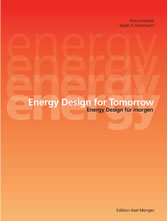Suchen und Finden
Service
Energy Design for Tomorrow. Energie Design für morgen
Klaus Daniels, Ralph Hammann
Verlag Edition Axel Menges, 2009
ISBN 9783936681253 , 368 Seiten
Format PDF
Kopierschutz DRM
Geräte
The challenges facing the 21st century are staggering: rapidly increasing population, mounting social instability due to global imbalances of wealth and welfare, resource scarcity and resulting conflicts related to their exploitation and distribution, and certainly the ongoing distress of the environment as a whole. Such severe conditions, including climate change, continue to become greater in number, complexity, and clarity, even though most of them had already been introduced as areas of concern in the 1970s and 1980s. Part I of the book describes potential strategies that will play an essential role in curbing carbon emissions, reducing – or replacing – fossil fuel usage. To better understand the current global energy industry, the book is unique in showing energy consumption data across the globe in comparable units, and it explains how fossil fuels could be replaced by renewable energy resources. Part II explains how the necessary significant reductions in energy consumption can be achieved by alternative means at reasonable cost for power generation to be maintained. A great number of projects are described in the book as case studies that fulfill the variety of current international energy code.
Part III addresses the technological possibilities for energy savings and resource-sensitive solutions related to buildings. Here, the potential of building-integrated solar systems, wind-power generation, rain-water harvesting, and the use of geothermal energy, as well as their implementation in the architecture are presented in detail. On the one hand, the book presents the background for a broader understanding of the medium-range and long-range changes in our energy landscape, and on the other it provides the basis for avenues required to enable us to design strategies based on local conditions and individual geographical locations.
Over the past 20 years, Klaus Daniels and the engineers of his engineering consultancy HL Technik have published four volumes of seminal work related to this subject, and their work is continuously being updated. In this series, the new book is an attempt to illustrate how modern architecture needs to be adaptive to energy conditions and how design and technology can be blended successfully. Klaus Daniels has devoted four decades to advanced engineering solutions as a consulting engineer. From 1991 to 2006 he taught at the Swiss Federal Institute of Technology (ETH). In 2006, the Technical University of Munich, Germany, celebrated his work with an honorary doctorate in engineering. Ralph Hammann is a professor of design and sustainable building systems in the Department of Architecture of the University of Illinois at Urbana-Champaign.
Service
Shop



